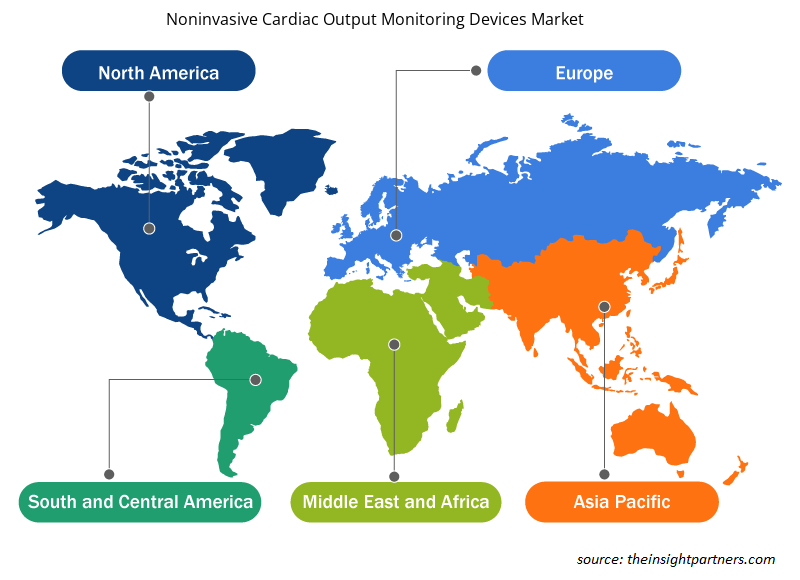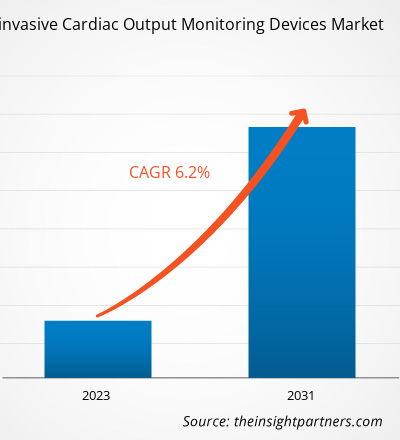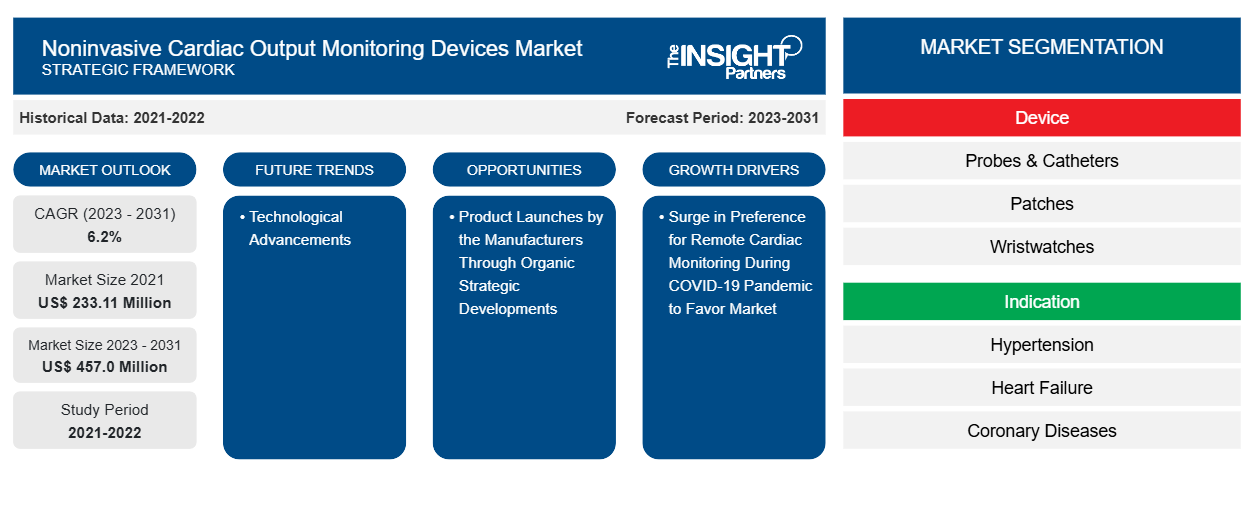Le marché des dispositifs de surveillance du débit cardiaque non invasifs était évalué à 233,11 millions USD en 2021 et devrait atteindre 457,0 millions USD d'ici 2031. Le marché devrait enregistrer un TCAC de 6,2 % de 2023 à 2031. Les avancées technologiques devraient rester des tendances clés sur le marché des dispositifs de surveillance du débit cardiaque non invasifs. CAGR of 6.2% from 2023 to 2031. Technological advancements are likely to remain key trends in the noninvasive cardiac output monitoring devices market.
Dispositifs de surveillance du débit cardiaque non invasifsAnalyse globale du marché
La mesure du débit cardiaque (DC) est essentielle dans la pratique médicale. Par le passé, la surveillance cardiaque invasive était le traitement de référence pour le diagnostic. Cependant, ces dernières années, plusieurs dispositifs de surveillance du débit cardiaque non invasifs ont été développés par les principaux fabricants de dispositifs médicaux. Ces dispositifs sont des produits technologiquement avancés offrant des solutions alternatives aux populations cardiaques réticentes à subir un traitement diagnostique cardiaque invasif.
Aperçu du marché des dispositifs de surveillance du débit cardiaque non invasifs
La technologie, l'innovation et les solutions technologiques intelligentes continuent d'influencer positivement et de manière significative la croissance du marché des dispositifs de surveillance du débit cardiaque non invasifs . Le progrès technologique est une tendance clé pour la croissance du marché. Les lancements de nouveaux produits par les fabricants grâce à des développements stratégiques organiques offriront des opportunités lucratives pour la croissance du marché des dispositifs de surveillance du débit cardiaque non invasifs au cours de la période de prévision.
Personnalisez ce rapport en fonction de vos besoins
Vous bénéficierez d'une personnalisation gratuite de n'importe quel rapport, y compris de certaines parties de ce rapport, d'une analyse au niveau des pays, d'un pack de données Excel, ainsi que de superbes offres et réductions pour les start-ups et les universités.
-
Obtenez les principales tendances clés du marché de ce rapport.Cet échantillon GRATUIT comprendra une analyse de données, allant des tendances du marché aux estimations et prévisions.
Dispositifs de surveillance du débit cardiaque non invasifsMoteurs et opportunités du marché
Augmentation de la préférence pour la surveillance cardiaque à distance pendant la pandémie de COVID-19
pour favoriser le marché
Les technologies de surveillance cardiaque à distance des patients contribuent à remodeler la gestion des troubles cardiaques en rendant la prestation de soins de santé efficace et accessible. Par exemple, les technologies de nouvelle génération telles que les défibrillateurs et les stimulateurs cardiaques gérés à distance stimulent la demande de soins cardiaques à distance. La surveillance cardiaque à distance progresse grâce à une gestion efficace des données des appareils, ce qui a entraîné l'adoption d'appareils de surveillance cardiaque non invasifs avancés. En outre, le gouvernement a apporté son soutien à la surveillance des signes vitaux à distance dans le cadre de la pandémie de COVID-19. Par exemple, en mars 2020, l'USFDA a annoncé l'autorisation d'une utilisation élargie d'appareils permettant de surveiller les signes vitaux des patients à distance. Permettre l'utilisation à distance d'appareils cardiaques à distance peut aider les prestataires de soins de santé à accéder aux informations sur les signes vitaux des patients pendant que le patient est à domicile, réduisant ainsi le besoin de visites à l'hôpital et minimisant le risque d'exposition au nouveau coronavirus. En outre, les principaux fabricants de dispositifs médicaux ont lancé des appareils innovants de surveillance du débit cardiaque non invasifs pendant la pandémie de COVID-19. Par exemple, en mai 2020, Octagos Health, une start-up du secteur de la santé basée à Houston, a annoncé le lancement d’une plateforme logicielle de surveillance à distance de nouvelle génération pour les patients porteurs d’appareils cardiaques implantés. Le logiciel Octagon permet aux professionnels de la santé d’accéder aux patients cardiaques, aux stimulateurs cardiaques et aux défibrillateurs à l’aide d’un seul portail. En outre, le logiciel simplifie la gestion des transmissions à distance et fournit simultanément des informations et des analyses en temps réel sur les patients dans une plateforme sécurisée et basée sur le cloud. Par conséquent, l’approche des dispositifs de surveillance cardiaque à distance contribuera de manière significative à la croissance du marché des dispositifs de surveillance du débit cardiaque non invasifs.USFDA announced the allowance of expanded use of devices to monitor patients' vital signs remotely. Allowing remote cardiac devices to be used remotely can help healthcare providers access information about patients’ vital signs while the patient is at home, reducing the need for hospital visits and minimizing the risk of novel coronavirus exposure. Furthermore, key Octagos Health, a Houston-based healthcare startup company, announced the launch of a next-generation remote monitoring software platform for patients with implanted cardiac devices. The Octagon software allows healthcare professionals access to cardiac patients, pacemakers, and defibrillators using one portal. Also, the software simplifies the management of remote transmissions and simultaneously provides real-time patient insights and analytics in a secure and cloud-based platform. Therefore, the remote cardiac monitoring devices approach will contribute significantly to the noninvasive cardiac output monitoring devicesmarket growth.
Progrès technologiques
Les progrès technologiques ont encouragé les fabricants de dispositifs médicaux à concevoir des produits innovants. Les technologies émergentes offrent des alternatives efficaces à la surveillance cardiaque traditionnelle, en créant des alertes pour les patients à risque de maladie cardiovasculaire. La télémétrie cardiaque mobile (MCT) est un exemple de dispositif de surveillance cardiaque technologiquement avancé. Le système MCT aide à surveiller l'état cardiaque des patients cardiaques. Les patients portent un minuscule capteur et un moniteur tout au long de la journée. Chaque fois qu'un événement cardiaque se produit, le MCT envoie les données à un système central pour analyse et réponse. Le système génère un rapport contenant des graphiques et des tendances et le partage avec les médecins du patient pour une action ultérieure. Les systèmes MCT peuvent analyser chaque battement de cœur et détecter des irrégularités dans les conditions normales d'un patient, puis déclencher une réponse d'urgence immédiate, ce qui en fait l'une des options les plus préférées pour la surveillance cardiaque. Par conséquent, l'adoption de tels dispositifs de surveillance du débit cardiaque non invasifs technologiquement avancés répond aux besoins de santé d'un patient, ce qui stimule la croissance du marché des dispositifs de surveillance du débit cardiaque non invasifs.MCT) is an example of a technologically advanced cardiac monitoring device product. The MCT system assists in monitoring the heart conditions of cardiac patients. Patients carry a tiny sensor and monitor throughout the day. Whenever a cardiac event occurs, the MCT sends the data to a central system for analysis and response. The system generates a report containing graphs and trends and shares it with the patient's physicians for further action. MCT systems can analyze every heartbeat and detect irregularities in a patient's normal conditions, followed by initiating an immediate emergency response, which makes them one of the most preferred options for cardiac monitoring. Therefore, the adoption of such technologically advanced noninvasive cardiac output monitoring devices meets the healthcare needs of a patient, which drives the noninvasive cardiac output monitoring devicesmarket growth.
Lancements de produits par les fabricants grâce à des développements stratégiques organiques
Les fabricants investissent dans la conception de dispositifs innovants de surveillance du débit cardiaque non invasifs pour mieux connecter les hôpitaux aux patients cardiaques. Voici quelques développements réalisés par les fabricants.
- En juin 2021, Max Healthcare a lancé un cadre de surveillance des patients intégré à un appareil alimenté par l'intelligence artificielle (IA), qui serait le premier du pays. Max Healthcare est l'un des plus grands fournisseurs de soins de santé en Inde, avec plus de 15 hôpitaux ultra-spécialisés, des diagnostics et des services intégrés de soins à domicile. Il a lancé le service de surveillance des patients alimenté par l'IA en collaboration avec un fournisseur de solutions de santé numérique nommé MyHealthcare. L'écosystème Max MyHealth+, créé en collaboration avec MyHealthcare, a intégré des tensiomètres, des appareils d'ECG et de fréquence cardiaque et des appareils de surveillance de la glycémie.
- En mai 2021, VitalConnect, Inc., l'un des principaux fournisseurs de technologies de biocapteurs pour la surveillance à distance et en milieu hospitalier, a lancé la solution de télémétrie cardiaque mobile (MCT) VitalPatch RTM. Il s'agit de la seule solution de surveillance cardiaque disponible avec une plateforme flexible et programmable couvrant de multiples besoins de surveillance cardiaque. Uniquement disponible chez VitalConnect, la plateforme permet une détection continue et en temps réel des arythmies cardiaques tout en mesurant simultanément les paramètres physiologiques du patient.
De telles activités stratégiques sont susceptibles d’offrir des opportunités lucratives au marché des dispositifs de surveillance du débit cardiaque non invasifs pour stimuler l’innovation au cours de la période de prévision.
Dispositifs de surveillance du débit cardiaque non invasifs
Analyse de segmentation du rapport de marché
Les segments clés qui ont contribué à l’élaboration de l’analyse du marché des dispositifs de surveillance du débit cardiaque non invasifs sont l’appareil, l’indication et l’utilisateur final.
- En fonction de l'appareil, le marché des dispositifs de surveillance du débit cardiaque non invasifs est segmenté en sondes et cathéters, patchs et montres-bracelets. Le segment des sondes et cathéters détenait la plus grande part de marché en 2023.
- En termes d'indication, le marché est segmenté en hypertension, insuffisance cardiaque, maladies coronariennes, ischémie et infarctus du myocarde, arythmies, problèmes congénitaux et autres. Le segment de l'hypertension détenait la plus grande part du marché en 2023.
- En termes d'utilisateur final, le marché est segmenté en hôpitaux, centres de services d'urgence, soins à domicile et autres. Le segment des hôpitaux détenait la plus grande part de marché en 2023.
Analyse des parts de marché des dispositifs de surveillance du débit cardiaque non invasifs par géographie
La portée géographique du rapport sur le marché des dispositifs de surveillance du débit cardiaque non invasifs est principalement divisée en cinq régions : Amérique du Nord, Asie-Pacifique, Europe, Moyen-Orient et Afrique, et Amérique du Sud et centrale.
L'Amérique du Nord domine le marché des dispositifs de surveillance du débit cardiaque non invasifs. Sur le marché nord-américain, les États-Unis représentent une part de marché considérable. La présence des principaux fabricants de dispositifs médicaux aux États-Unis et le lancement de produits technologiquement avancés par les fabricants comptent parmi les facteurs les plus influents responsables de la croissance du marché. L'Asie-Pacifique devrait enregistrer le TCAC le plus élevé dans les années à venir.
Dispositifs de surveillance du débit cardiaque non invasifs
Aperçu régional du marché des dispositifs de surveillance du débit cardiaque non invasifs
Les tendances et facteurs régionaux influençant le marché des dispositifs de surveillance du débit cardiaque non invasifs tout au long de la période de prévision ont été expliqués en détail par les analystes d’Insight Partners. Cette section traite également des segments et de la géographie du marché des dispositifs de surveillance du débit cardiaque non invasifs en Amérique du Nord, en Europe, en Asie-Pacifique, au Moyen-Orient et en Afrique, ainsi qu’en Amérique du Sud et en Amérique centrale.

- Obtenez les données régionales spécifiques au marché des dispositifs de surveillance du débit cardiaque non invasifs
Portée du rapport sur le marché des dispositifs de surveillance du débit cardiaque non invasifs
| Attribut de rapport | Détails |
|---|---|
| Taille du marché en 2021 | 233,11 millions de dollars américains |
| Taille du marché d'ici 2031 | 457,0 millions de dollars américains |
| Taux de croissance annuel composé mondial (2023-2031) | 6,2% |
| Données historiques | 2021-2022 |
| Période de prévision | 2023-2031 |
| Segments couverts |
Par appareil
|
| Régions et pays couverts |
Amérique du Nord
|
| Leaders du marché et profils d'entreprises clés |
|
Densité des acteurs du marché des dispositifs de surveillance du débit cardiaque non invasifs : comprendre son impact sur la dynamique commerciale
Le marché des dispositifs de surveillance du débit cardiaque non invasifs connaît une croissance rapide, tirée par la demande croissante des utilisateurs finaux en raison de facteurs tels que l'évolution des préférences des consommateurs, les avancées technologiques et une plus grande sensibilisation aux avantages du produit. À mesure que la demande augmente, les entreprises élargissent leurs offres, innovent pour répondre aux besoins des consommateurs et capitalisent sur les tendances émergentes, ce qui alimente davantage la croissance du marché.
La densité des acteurs du marché fait référence à la répartition des entreprises ou des sociétés opérant sur un marché ou un secteur particulier. Elle indique le nombre de concurrents (acteurs du marché) présents sur un marché donné par rapport à sa taille ou à sa valeur marchande totale.
Les principales entreprises opérant sur le marché des dispositifs de surveillance du débit cardiaque non invasifs sont :
- Baxter,
- Bio-Beat,
- GE Santé,
- Royal Philips NV,
- Abbé,
- Deltex Médical Limitée,
Avis de non-responsabilité : les sociétés répertoriées ci-dessus ne sont pas classées dans un ordre particulier.

- Obtenez un aperçu des principaux acteurs du marché des dispositifs de surveillance du débit cardiaque non invasifs
Dispositifs de surveillance du débit cardiaque non invasifsActualités du marché et développements récents
Le marché des dispositifs de surveillance du débit cardiaque non invasifs est évalué en collectant des données qualitatives et quantitatives après des recherches primaires et secondaires, qui comprennent d'importantes publications d'entreprise, des données d'association et des bases de données. Voici une liste des évolutions du marché :
- En janvier 2021, OMRON Healthcare, Inc. a lancé son premier service de surveillance à distance des patients au CES 2021, ainsi que de nouveaux outils de santé numériques, pour améliorer la communication entre les patients et les médecins et assurer une gestion active de l'hypertension. OMRON a présenté le premier tensiomètre portable ainsi que le premier tensiomètre avec ECG intégré au cours des trois dernières années. Grâce à ces innovations, elle continue de transformer le marché mondial de la santé cardiaque et de soutenir sa mission « Going for Zero heart attack and AVC ».
Dispositifs de surveillance du débit cardiaque non invasifs - Rapport de marché sur la couverture et les livrables
Le rapport « Taille et prévisions du marché des dispositifs de surveillance du débit cardiaque non invasifs (2021-2031) » fournit une analyse détaillée du marché couvrant les domaines ci-dessous :
- Taille et prévisions du marché des dispositifs de surveillance du débit cardiaque non invasifs aux niveaux mondial, régional et national pour tous les segments de marché clés couverts par le champ d'application
- Tendances du marché des dispositifs de surveillance du débit cardiaque non invasifs ainsi que la dynamique du marché, comme les facteurs moteurs, les contraintes et les opportunités clés
- Analyse détaillée des cinq forces de PEST/Porter et SWOT
- Analyse du marché des dispositifs de surveillance du débit cardiaque non invasifs couvrant les principales tendances du marché, le cadre mondial et régional, les principaux acteurs, les réglementations et les développements récents du marché
- Analyse du paysage industriel et de la concurrence couvrant la concentration du marché, l'analyse de la carte thermique, les principaux acteurs et les développements récents pour le marché des dispositifs de surveillance du débit cardiaque non invasifs
- Profils d'entreprise détaillés
- Analyse historique (2 ans), année de base, prévision (7 ans) avec TCAC
- Analyse PEST et SWOT
- Taille du marché Valeur / Volume - Mondial, Régional, Pays
- Industrie et paysage concurrentiel
- Ensemble de données Excel
Rapports récents
Témoignages
Raison d'acheter
- Prise de décision éclairée
- Compréhension de la dynamique du marché
- Analyse concurrentielle
- Connaissances clients
- Prévisions de marché
- Atténuation des risques
- Planification stratégique
- Justification des investissements
- Identification des marchés émergents
- Amélioration des stratégies marketing
- Amélioration de l'efficacité opérationnelle
- Alignement sur les tendances réglementaires























 Obtenez un échantillon gratuit pour - Marché des dispositifs de surveillance du débit cardiaque non invasifs
Obtenez un échantillon gratuit pour - Marché des dispositifs de surveillance du débit cardiaque non invasifs